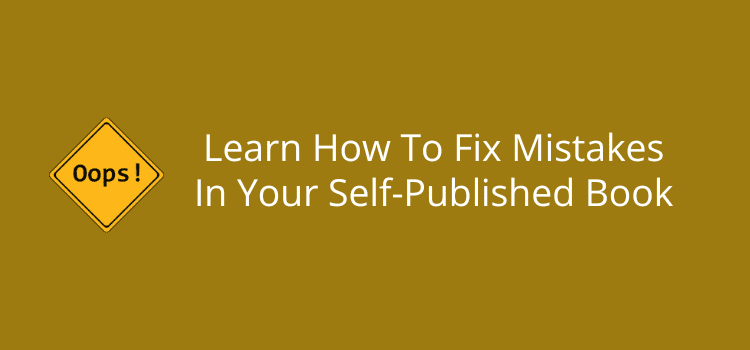
Don’t panic if you notice an error or typo, because it’s easy to fix mistakes in your self-published book.
It’s rare to find a book that is perfect without an occasional typo or misspelling. So, you are not alone by any means if you spot an error after publishing your ebook or book.
The most common mistakes in self-published books are formatting glitches, wrong words, and typos created by a slip of the finger. No matter how carefully you proofread your book, it’s a rarity for any manuscript to be 100% correct.
Traditionally published books are rarely error-free either, and have to wait for a new print run before errors can be corrected. But fortunately for self-published authors, you can apply a fix as soon as you notice it.
How common are errors in published books?
Many new authors might have this question. “Is it common for books to have errors?” The answer is a resounding yes.
You’ll find typos, formatting inconsistencies, and minor mistakes in almost any book.
Even books by high-profile authors who are traditionally published are not immune.
Most readers will read past the occasional error, but if errors are more frequent, it can have a negative effect on readers.
What matters most is how quickly you can address any issues that you might find.
Luckily, it’s a relatively easy and quick fix for any small mistakes that might have slipped through.
It’s happened to me more times than I would like to admit. But I recall one that annoyed me the most. It was a typo of “you” instead of “your”. Not a big one, but as it was on page one, it was a huge error for me.
However, I had received many terrific reviews, sold quite a few copies, with no negative feedback, before I discovered the error.
It only goes to show you that there is often no need to hit the panic button if you suddenly notice a stray typo or two.
If you discover that there are more than a few errors or format issues, it’s still a pretty easy fix.
How to correct mistakes after self-publishing
Before you rush in to fix a typo you notice, slow down a bit, because if there’s one error, there’s bound to be more.
But if it’s a minor error that you believe needs to be fixed immediately, all you need to do is make the correction in your manuscript and upload the new version to your publishing platform.
However, it’s probably only a short-term fix, but it will set your mind at rest.
In truth, there are likely to be more errors that you have missed. The only way to be sure is to do a complete proofread of your manuscript to catch more typos and errors.
When you have finished, you will more than likely find a few more corrections.
The good news is that with any self-publishing service, such as Amazon KDP or Draft2Digital, updating your manuscript is quick and easy.
You are not republishing your book, only updating, so there will be no change to your book’s listing, availability, or reviews.
An update to your book usually takes between 24–48 hours to propagate, so be patient.
It might be less common, but typos can also happen with book covers, such as with capitalized prepositions. Again, it’s a simple fix. Correct your cover text and upload it again. You can change your book cover any time, as long as the title, subtitle, and author name stay the same.
You can make many other changes apart from typo corrections to your book that only require an update.
It’s possible to change or adjust formatting, modify and update your metadata, and change categories or search keywords. You can also change your selling price.
One very important point to note is that people who have bought your ebook will not automatically receive an updated version.
They can do it manually if it’s a Kindle ebook by using their “Manage Your Kindle” page. But most people would rarely bother.
Logically, any paperback copies you have sold will be your old version.
However, for new buyers of your book, you can be satisfied that you are providing a better version, free of errors.
What you can’t fix when you update a self-published book
While you can update your book at any time, and as often as you like, some changes are not possible.
Specifically, you can’t change the primary author, but you can change contributors. You can’t change your book title or subtitle, or the digital rights management setting for ebooks.
Another change that you can’t make by simply updating is if you want to make major changes to your manuscript, such as adding new chapters.
In these instances, your only option is to republish your book as a new edition. But this has some serious drawbacks.
In effect, you are publishing a brand-new book. So you will lose all of your reviews, and your new version will appear on a new sales page. Therefore, any promotional links you have for your existing book will not work.
It’s a drastic step, and one you should avoid at all costs. I did this with one book quite some time ago, and it turned into a nightmare to manage.
The problem is that you end up with two versions of your book being available on Amazon and other retailers, because it’s impossible to delete a print book.
It’s slightly better news for an ebook version. You can unpublish your old version, and it should disappear quite quickly.
However, it’s far better to stay within the limits of what you can update to fix mistakes in your self-published book or ebook.
Correcting errors in ebooks is easier and quicker than for a print book. But if you have two versions, don’t forget to update both.
How many typos are acceptable in a book?

There’s no magic number, but most readers will put up with, or ignore, a few minor errors in a novel.
However, more than that is opening up the possibility of poor book reviews that might highlight typos or obvious grammar mistakes.
But it’s important to differentiate perfectionism from practicality.
A perfect book, free of any errors, is an absolute rarity. Your aim should be to provide the best reading experience.
That doesn’t mean you can catch every minor typo, such as a missing closing quotation mark, a missing or additional comma (often debatable anyway), or a semicolon instead of a colon.
If it’s any consolation, a study has found that books by Ernest Hemingway contain hundreds of errors.
In another example, Stephen King revised parts of The Gunslinger decades after its original release.
One update included: “Reference to 12 years having passed since the fall of Gilead, which happened when Roland was a teenager, is changed to unknown years. Otherwise, it would be deduced that Roland is in his 30s, whereas later books imply Roland is ancient.”
However, this doesn’t mean that errors are acceptable.
One practical way to fix typos in a book is to use the errors you find as a starting point. If you find a misspelling of a character’s name, search your manuscript for every mention to see if there are more typos.
The same goes for common spelling mistakes like then and than, you and your, or their and there.
Will you catch every single error or grammar mistake? Probably not, but you will reduce them considerably.
How mistakes in books are reported
Readers can so easily publish book reviews that highlight errors they find.
It is not the ideal way to discover mistakes in your book, so being proactive and updating your book can help avoid this.
If you publish with Amazon KDP, you might receive quality notifications by email.
These often highlight spelling errors, typos, image quality, poor formatting, or conflicting category selections. For example, you might see: “Kindle Location: 6866 ; Description: “there where times when” should be “there were times when”
If you receive a quality notification, react to it immediately and correct the issues. Then, update your book as soon as possible. With KDP, you can follow the review process from your dashboard.
Summary
Mistakes in self-published books are common, but that doesn’t mean that they are acceptable.
After you publish your book, keep your eyes peeled for possible errors. Perhaps even read your book again in the first week or so after publishing.
Check your book reviews or mentions of your book on social media and react quickly if you receive a quality notification from your publishing platform.
Errors happen, but it’s so easy to fix mistakes in your self-published book. Catch them early, and you will avoid them affecting your reputation.
Related Reading: The Legal Aspects Of Self-Publishing For New Authors
Share This Article


